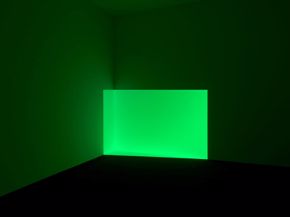Assembling “The Light Inside” August 9, 2013

James Turrell, Acro, Green, 1968, projected light, the Museum of Fine Arts, Houston, Museum purchase. © James Turrell
James Turrell, Caper, Salmon to White: Wedgework, 2000, LED and fluorescent light, the Museum of Fine Arts, Houston, Museum purchase funded by the estate of Isabel B. Wilson in memory of Peter C. Marzio. © James Turrell
View of Brown Pavilion's free-span exhibition space, prior to the installation of any art.
I interviewed the Museum’s own Russ Lane, who served as lead preparator for James Turrell: The Light Inside. We talked about the unique requirements of this special exhibition and Russ’s father’s interest in flying, a shared experience that has created an even deeper appreciation of Turrell’s work.
SS: Hello, Russ! Can you introduce yourself?
RL: My name is Russ Lane, and I am a preparator (or art handler) at the MFAH. I started at the Museum in 2008. Before that, I studied agricultural journalism at Texas A&M.
SS: You were the lead preparator for James Turrell: The Light Inside. How far in advance did you start planning for the show?
RL: It was a unique installation, as both the architectural build out for the show and the artwork were one. After Turrell and our curator of Contemporary Art and Special Projects, Alison de Lima Greene, agreed upon the exhibition design, most of the nuts-and-bolts planning was done through the office of our associate director in charge of administration, Willard Holmes. I joined the project during one of the final construction meetings, some three months before the show opened.
SS: What is a preparator’s job? How did this show differ from the usual exhibition?
RL: Preparators install all the objects exhibited in a show: typically paintings, sculptures, and works on paper. After an exhibition opens, the preparators are in charge of general cleanliness of the exhibition space. We routinely survey the conditions of the objects so that they appear as they did when we first installed them. In the case of the Turrell exhibition, it is particularly important that the spaces remain pristine and that all the lighting equipment is operating smoothly. I go into the galleries every morning before we open to the public.
SS: Did Turrell and his staff work closely with you?
RL: Yes, Turrell was very involved with the planning stages from the start, and he had his studio assistants come down periodically from Flagstaff, Arizona, to check on our progress. Matt Schreiber from Baltic Studio came down several times as well. Toward the end, we all worked together with Turrell fairly intensely to get the lighting effects exactly right.
SS: Can you explain what Baltic Studio is and how it’s associated with the artist?
RL: Matt set up Baltic Studio in Brooklyn, New York, to handle the technical side of Turrell’s light installations. In addition to working as Turrell’s most trusted collaborator, Matt is an artist in his own right.
SS: Is there any risk of the technology becoming obsolete?
RL: Turrell has been showing these works for some 40 years—in some cases he has embraced new technologies, such as LED, but in others he is still using the simplest means. Acro, Green, for example, is created using a high-caliber projector with a green filter, essentially the same equipment he used to create his first projections of the 1960s.
SS: Does knowing how Turrell’s works are constructed affect the way you see the work?
RL: No, in fact it’s easy to forget about the structure when you are looking at the installations themselves, although it is amazing to see these spaces from above!
SS: Were you familiar with Turrell’s work before this exhibition?
RL: I had read a lot about his work, and of course I was familiar with The Light Inside installed in the Wilson Tunnel here at the Museum. I’ve always really liked his “Skyspaces” as well. In getting ready for this show, I read a lot, and I was fascinated to learn about his love of flying. My dad’s a private pilot, so that was really interesting to me.
SS: So you’ve been in the sky a lot?
RL: Yes, I also used to work at a general aviation terminal in college. I got to talk to Turrell about it.
SS: That would be noncommercial aviation?
RL: Yes, for people like Turrell and my dad. My dad lives in the Ozarks, near the Arkansas-Missouri border in a town called Calico Rock. He flies off of an old grass pasture that he turned into a landing strip; it’s a little island that is accessible by a cattle bridge.
SS: When Turrell talks about the wedging that happens when a cold front pushes against a warm front [a phenomenon that he captures in his Wedgework series], did you know what he was talking about?
RL: No, I’ve never experienced it that way. But you do see strange things when you’re flying.
SS: What do you take away from the experience of working with James Turrell?
RL: It’s totally unlike any exhibition that I’ve been a part of. The experience of working with an artist I really admire and have come to like as well was terrific.





